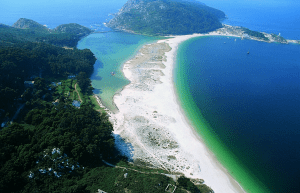Extraordinary landscapes in the country
Spain is one of the European countries with the greatest biodiversity since in its territory there are up to 121 different types of habitats. This can be explained by Spain’s geographical location; the Iberian Peninsula is in between two continents, has more than 7,000 kilometers of coastline and 6 different climatic regions. Depending on the area of Spain, you can enjoy the maritime climate of the west coast, continental Mediterranean, coastal Mediterranean, southwestern Mediterranean, dry subtropical and dry and humid tropical.
In 1916 a royal decree was passed to create the first national park. The goal was to establish natural spaces protected by laws that would prevent alterations of the natural balance. Nowadays, there are 15 national parks in Spain with unique landscapes, ten of them located in the Iberian Peninsula and five in the Balearic and Canary Islands.
Today we bring you a compilation of the 10 best national parks in Spain, so you can learn more about the biodiversity you will find in each of them and make a choice of which ecosystem you would like to explore most.
TABLE OF CONTENTS
- Best National Parks in Spain to visit this summer
- Monfragüe National Park
- Timanfaya National Park
- Picos de Europa National Park
- Aigüestortes i Estany de Sant Maurici National Park
- Sierra Nevada National Park
- Doñana National Park
- Garajonay National Park
- Ordesa y Monte Perdido National Park
- Tablas de Daimiel National Park
- Teide National Park
Best National Parks in Spain to visit this summer
Monfragüe National Park

Located in the Cáceres region, the Monfagüe National Park is one of the best preserved Mediterranean existent forest ecosystems. Declared national park in 2007, this park stands out especially for its diverse fauna, composed by more than 200 different species of vertebrate animals. Among its leisure activities, you can find off-road vehicle rides, birdwatching or visit the famous Monfragüe castle. Its towers are the best spot to observe the park’s most representative birds of prey: the black vulture, the imperial eagle, and the black stork.
Timanfaya National Park
The Timanfaya National Park, located in Lanzarote, in the Canary Islands is one of the most spectacular national parks in Spain. The park’s main geographical features are its black stones, its columns of steam and its dark landscapes, due to its origin produced by volcanic eruptions that took place in the XVIII and XIX centuries. But this does not mean that there is no biodiversity in Timanfaya; In its 5,000 hectares surface, we can find animals and plants adapted to the lack of water and the extreme heat, from lichens to spiders. The reddish and black color of its landscapes make that when visiting it, we feel like we have traveled to the planet Mars.
Picos de Europa National Park

One of the most striking qualities of the Picos de Europa National Park is that, in its 67,455 hectares surface, all different species that form the Cantabrian fauna are represented. The flora of this national park in Spain is also exceptional, thanks to the Mediterranean and Atlantic climates that mixes producing singular vegetation. Its geography is composed of mountains, valleys, forests, rivers, and gorges. Among the activities, you can do in the national park are the kayak descents, hiking or sightseeing to the different towns within the park area.
Aigüestortes i Estany de Sant Maurici National Park
This is the only national park located in Catalonia and it has its certification since 1955. The park has two areas with different climates: the high-mountain Atlantic and the mild continental climate. Its extension exceeds 40,000 hectares and occupies four different Catalan regions: Pallars Sobirà, Pallars Jussà, Alta Ribagorça, and Val d’Aran. The main leisure activity of the park is to arrange natural tours on foot or by bicycle to appreciate the fauna and vegetation, as well as visiting the Sant Maurici lake. The most popular route is known as “Carros de Foc” (chariots of fire), a circular route that lasts 6 days and in which you will spend the night in the different refuges of this national park, living an amazing mountain adventure.
Sierra Nevada National Park
The Sierra Nevada is the largest national park in Spain by extension, reaching 86,210 hectares. Its name has changed throughout history according to the predominant culture in the Iberian Peninsula. Romans referred to it as Solaris (sun mountain), Visigoths as Mont Oriens (the mountain where the sun shines before leaving) and Arabs like Jabal Sulayr (air mountain). Since 1989, it has been classified as a national park due to the representative nature of its ecosystem, which is a perfect example of the Mediterranean high mountain climate. In addition to the park, Sierra Nevada hosts one of the most popular places for skiing in the country.
Doñana National Park

Doñana National Park is located in the south of Spain and represents a true crossroads between Africa and Europe, as well as between the Atlantic Ocean and the Mediterranean Sea. In its 108,086 hectares surface, archaeologists have found remains of the Neolithic era, as well as Roman settlements lands used as hunting grounds by the kings of Spain in the past. Its mild Mediterranean climate results in an ecosystem of forest, beaches and sandy grounds with an abundance of plant life. Its most famous animal is the Lince Ibérico (Iberian lynx), one of the most native animals in Spain.
Garajonay National Park
This national park is in La Gomera and is known for housing one of the native ecosystems of the Canary Islands: Laurisilva Canaria. This habitat disappeared millions of years ago from the Iberian Peninsula, being La Gomera island one of its last redoubts. In Garajonay you will have the feeling of having traveled back to the age of the dinosaurs, given its lush vegetation and the mist that covers its dense forests. In this national park, you will find lichens, fungi, mosses and a great variety of bright colors flowers. Plus, on this impressive island, you will have the chance to get to know Silbo Gomero, the only whistled language in the world, to the point that it has the status of World’s Heritage.
Ordesa y Monte Perdido National Park
This national park is located in the Aragon region, in the middle of the Pyrenees mountains. The name “Monte Perdido” (Lost Hill) comes from the fact that it was not discovered until 1797 by the French geologist and botanist Ramond de Carbonières. It is the second oldest national park in Spain, having earned that name in 1918 and it receives more than 600,000 visitors per year. With limestone mountains shaped by erosion during the Quaternary era and a Pyrenean climate, its summits are usually covered in snow during most of the year. However, the different heights cause that in the same park there are very diverse climates, in addition to the variety of flora and fauna. Its most representative animals are the snow ptarmigan, the lammergeyer, and the Pyrenean frog.
Tablas de Daimiel National Park
Located in the Ciudad Real region, Tablas de Daimiel National Park is one of the largest examples of what is called the “ecosistema de tablas fluviales” (fluvial terraces ecosystem). This ecosystem is composed of wetlands that are formed by rivers overflowing, resulting in a unique landscape in Spain. In 1325 the area was a popular hunting area for aquatic birds using the falconry technique (hunting by trained falcons). The wetlands and their remarkable biology turned Tablas de Daimiel in a halt for migratory birds, which stop in the wetlands to feed themselves before continuing their journey.
Teide National Park

Teide National Park is in the highest area of Tenerife, also in the Canary Islands. It is the most visited national park in Europe and the most visited volcanic land area in the world after Japan’s Mount Fuji. Its ecosystem is composed by vegetation and fauna that has adapted to the harsh conditions caused by its volcanic origins, such as hares, lizards and some species of migratory birds that spend part of the year in its summits. Its characteristic reddish color has turned it into a setting for movies, a meeting place for religious cults and even a testing ground for NASA vehicles.
Featured image: Picos de Europa National Park, Asturias








